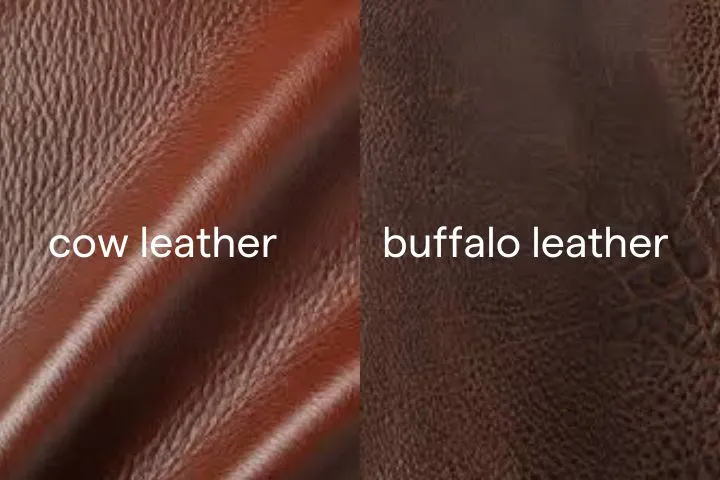Introduction
In the vast world of leather, one material stands out for its rugged charm and legendary toughness: buffalo leather. Prized for its deep, distinctive grain and incredible strength, it has become a go-to choice for high-quality bags, jackets, and accessories that are built to last. Yet, for all its popularity, a surprising amount of confusion surrounds buffalo leather. Is it the same as American bison? Is it truly stronger than cowhide? As the global leather market continues to grow, understanding the unique properties of this material is more important than ever for brands and consumers alike.
Buffalo leather is a highly durable and unique material derived from the hides of the water buffalo. It is characterized by its pronounced, pebbled grain pattern, exceptional thickness, and remarkable strength—often considered stronger than traditional cowhide. This type of leather is prized for its ability to develop a rich, beautiful patina over time, making it a premium choice for long-lasting, heritage-quality bags, footwear, and rugged accessories.
Choosing buffalo leather is an investment in a product that tells a story—one of resilience and character. However, to truly appreciate its value, you need to understand where it comes from, how manufacturers make it, and what makes it different from all the other leathers on the market. This guide will serve as your expert resource, taking you on a journey from its historical origins to its modern-day applications. We’ll compare it head-to-head with other leathers, break down its pros and cons, and give you the knowledge you need to choose, style, and care for it with confidence.
What is Buffalo Leather? Origins and Sources
Buffalo leather is a genuine leather derived from the tanned hide of the water buffalo (Bubalus bubalis), primarily sourced from countries like India and Pakistan. It is distinct from American bison leather, though people often confuse the terms. With a history rooted in ancient utility for tools and armor, this rugged material is prized today for its exceptional strength and unique, deep grain pattern.

Definition and Basic Facts
At its most basic, buffalo leather is the finished hide of a buffalo that has undergone a tanning process. However, this is where the first major point of confusion arises. The term “buffalo” can refer to two different animals:
- The Water Buffalo (Bubalus bubalis): This is the animal most commonly associated with buffalo leather in the global market. Native to Asia, the water buffalo is a domesticated animal that people use for agriculture and food, which makes its hide a valuable byproduct.
- The American Bison: Often colloquially called a “buffalo,” the American bison is a distinct species found only in North America. Manufacturers also use its hide for leather, but it is rarer, and brands typically market it specifically as “bison leather.”
When you see a product labeled simply as “buffalo leather,” you can be almost certain it comes from the hide of the water buffalo. Bison leather is a more niche, premium product that brands usually label as such to justify its higher cost.
Where Does Buffalo Leather Come From?
The primary sources of buffalo leather are directly linked to the regions where water buffalo are most populous. Since these animals are integral to agriculture in many parts of the world, their hides are readily available. This makes the leather an ethical and sustainable choice when sourced responsibly. The main hubs for sourcing and tanning buffalo hides are:
- India: The world’s largest producer of buffalo leather, with a massive domestic population of water buffalo.
- Pakistan: Another major player in the global leather market, with a strong industry focused on tanning buffalo hides.
- Other Asian Countries: In addition, nations like Nepal, Vietnam, and Thailand also contribute to the global supply.
In contrast, American bison leather is sourced exclusively from the USA, where the bison population is carefully managed.
Historical Background and Cultural Significance
The use of buffalo hide is steeped in history. In ancient Asia, people valued the thick, tough hide of the water buffalo, using it to create everything from shields and armor to rudimentary tools and footwear. Its strength made it a material of survival. Similarly, in North America, the bison held immense cultural and spiritual significance for Native American tribes. They used every part of the animal and crafted the hide into clothing, shelter (tipis), and ceremonial items. This deep historical connection adds a layer of heritage and authenticity to modern buffalo and bison leather goods.
Is Buffalo Leather Real Leather?
Yes, absolutely. To answer a common question, buffalo leather is 100% real, genuine leather derived from an animal hide. You should not confuse it with synthetic alternatives like PU or PVC leather, which are plastics designed to mimic its appearance. When you buy a high-quality buffalo leather product, you are getting a natural, durable material with a unique character that man-made substitutes cannot replicate.
How is Buffalo Leather Made? The Production Process
Making buffalo leather is a multi-stage process. First, workers source and prepare raw hides by cleaning and salting. Next, the hides undergo tanning—most commonly vegetable-tanning for ruggedness or chrome-tanning for softness—to convert them into durable leather. Finally, tanners finish the leather through dyeing and oiling to achieve its desired texture, color, and strength, ready for manufacturing.
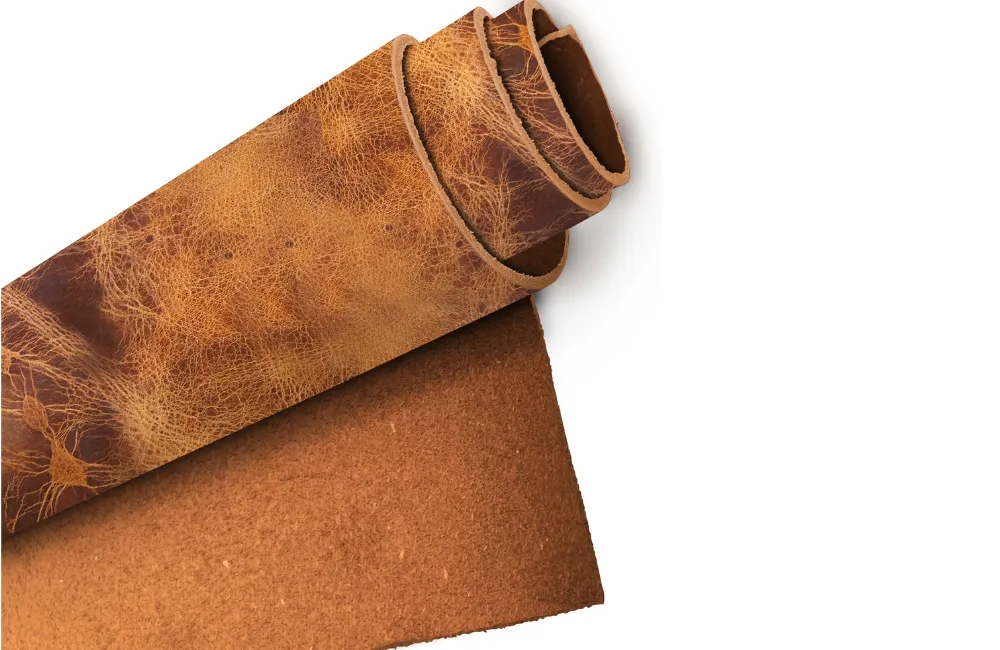
The journey from a raw buffalo hide to a finished piece of leather is a complex blend of traditional craft and modern science. Each step is crucial in developing the material’s signature strength and texture.
Sourcing and Preparation of Hides
The process begins with the raw hide, which is a byproduct of the food industry. The quality of the final leather is heavily dependent on the quality of the raw hide, which is influenced by the age and health of the animal. Once sourced, the hides undergo a preparation process:
- Curing: Workers salt the raw hides to prevent bacterial growth and preserve them for transport to the tannery.
- Soaking and Fleshing: At the tannery, workers soak the hides in water to rehydrate them and remove the salt and dirt. A fleshing machine then removes any remaining fat or muscle tissue from the inner side of the hide.
Tanning Methods for Buffalo Leather
Tanning is the chemical process that converts the raw hide into stable, durable leather. Tanners can use several methods for buffalo hides, each producing a different result:
- Vegetable-Tanning: This ancient, eco-friendly method uses natural tannins from tree bark. It’s a slow process that produces a firm, rugged leather that is perfect for durable bags and belts.
- Chrome-Tanning: A much faster chemical process that results in a softer, more pliable leather. This method is often used for buffalo leather intended for jackets or upholstery.
- Brain-Tanning: A traditional method, historically used by Native Americans for bison hides, which uses the emulsifying oils from the animal’s brain to create an incredibly soft, supple leather often used for garments.
Finishing and Dyeing Techniques
The finishing stage is where the leather’s final character is truly defined. This is where tanners create the deep colors and unique textures that buffalo leather is known for.
After tanning, the leather is dyed to achieve the desired color. It is then “fatliquored”—a process where tanners add oils and waxes back into the hide to make it supple and enhance its durability. Depending on the desired style, the leather may then be buffed to create a softer surface or embossed with an artificial pattern. For many high-quality buffalo leathers, very little finishing is done to the surface in order to preserve the beautiful, natural grain.
Types of Buffalo Leather and Their Unique Features
Buffalo leather comes in several types, each defined by the finishing process. Full-grain is the highest quality, showcasing the hide’s natural, rugged surface. Top-grain is sanded for a smoother, more uniform look. Pull-up leather is infused with oils and waxes, creating a dynamic, color-changing effect when bent. Each type offers a unique aesthetic, from the luxurious finish of Italian buffalo leather to the raw character of hunter leather.
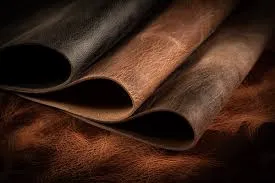
Just like cowhide, buffalo leather is available in different grades and finishes. The type you choose will have a significant impact on the look, feel, and performance of your product.
Full-Grain Buffalo Leather
This is the pinnacle of quality. Tanners make full-grain buffalo leather from the outermost layer of the hide, leaving the natural, pebbled grain and any unique markings completely intact without sanding or buffing.
- Characteristics: It has a deep, rugged texture and a rich, natural appearance. Furthermore, it is the strongest and most durable type of buffalo leather and will develop a stunning patina over time.
- Best For: High-end bags, durable belts, and heirloom-quality accessories where character and longevity are the top priorities.
Top-Grain Buffalo Leather
Top-grain is a high-quality option where the very surface of the hide has been lightly sanded to remove major imperfections. This process creates a more uniform, smoother finish than full-grain.
- Characteristics: It has a more consistent color and texture. While still very durable, it is slightly more pliable than full-grain and offers better stain resistance.
- Best For: Products where a cleaner, more polished look is desired, such as briefcases or more refined handbags.
Pull-Up Buffalo Leather
This is a type of full-grain leather that has been heavily treated with oils and waxes. When you bend or “pull up” the leather, the oils in the hide shift, causing the color to lighten in the crease. This creates a beautiful, dynamic, and slightly distressed look that is highly sought after.
Italian Buffalo Leather
Italian buffalo leather is not a separate species, but rather a mark of quality craftsmanship. It refers to buffalo leather that has been tanned and finished in Italy, a country renowned for its centuries-old tradition of luxury leather production.
People prize it for its exceptionally soft feel, rich colors, and luxurious finish, which often commands a premium price.
Other Variations (e.g., Hunter, Embossed)
Buffalo leather’s versatility allows for many other finishes. For instance, “Hunter” buffalo leather has a matte, distressed finish that gives it a rugged, vintage look from day one. Manufacturers can also emboss it with an artificial pattern, such as a crocodile print, to create a more exotic look at a lower cost.
Types Table: At a Glance
| Leather Type | Average Bulk Price / sq ft | Key Characteristic | Best Use Case |
|---|---|---|---|
| Full-Grain | $5 – $15 | Rugged, natural grain, develops patina | Heirloom Bags, Rugged Belts |
| Top-Grain | $4 – $10 | Smooth, uniform finish | Briefcases, Refined Accessories |
| Pull-Up | $6 – $12 | Dynamic, color-changing effect | Messenger Bags, Casual Footwear |
| Italian Buffalo | $8 – $20+ | Luxurious feel, rich color | High-End Fashion Goods |
Key Characteristics and Qualities of Buffalo Leather
Buffalo leather is renowned for its exceptional strength and durability, being 2-3 times thicker than cowhide with a more pronounced, pebbled grain. This makes it highly resistant to tearing and damage. It is also breathable and flexible, molding to the user over time. Its most prized quality is its ability to develop a rich, beautiful patina, making it an excellent choice for long-lasting, heritage-quality goods.
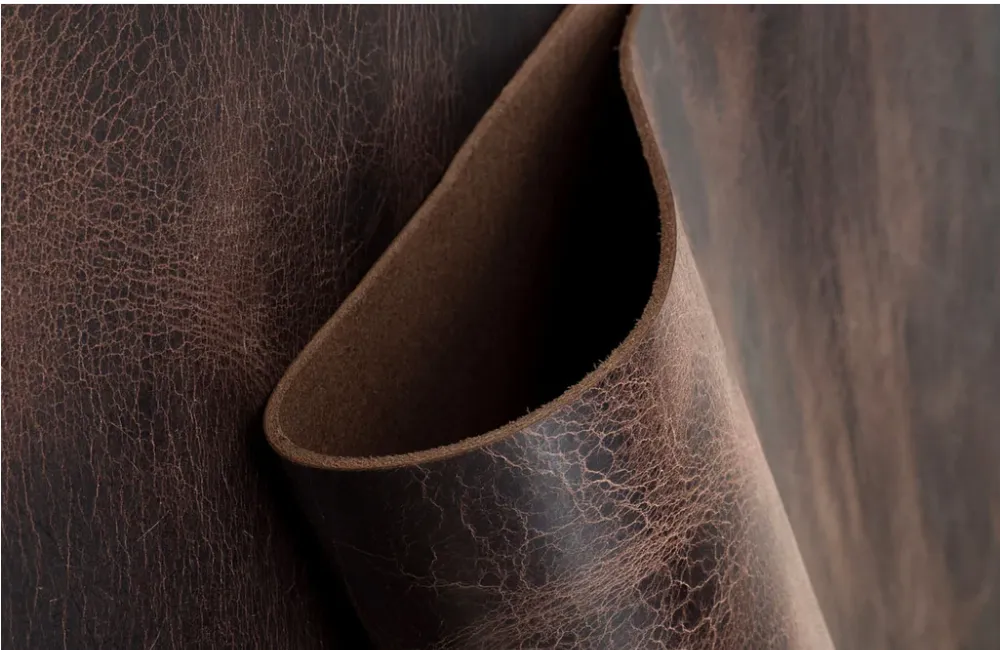
So, is buffalo leather good? Yes, its unique combination of strength, beauty, and character makes it one of the finest materials available for high-quality goods. Let’s break down its specific qualities.
Strength, Durability, and Thickness
This is buffalo leather’s most famous trait. The hide of a water buffalo has an epidermal layer that is up to three times thicker than cowhide, and its fibers are not as stretched out. This results in a material that is incredibly strong and resistant to tearing.
- Exceptional Durability: A product made from full-grain buffalo leather can withstand a lifetime of use, making it ideal for items that see a lot of wear, like travel bags and boots.
- Thickness: While it is thick, modern tanning techniques can produce buffalo leather that is both strong and flexible, suitable for a wide range of products.
Texture, Appearance, and Aging Process
Buffalo leather has a distinct and beautiful appearance that sets it apart from the smoother, more uniform look of cowhide. A deep, pebbled grain pattern defines its look, which gives it a rugged, earthy, and authentic character. This unique texture is not just for show; it also helps to hide minor scratches and scuffs.
Perhaps its most desirable quality is the way it ages. Like all high-quality, full-grain leathers, buffalo leather develops a rich patina over time. As it absorbs oils from your hands and is exposed to the elements, it will gradually darken and develop a beautiful, lustrous sheen that is unique to your use.
Breathability, Flexibility, and Comfort
Despite its thickness, buffalo leather is a surprisingly breathable material. Its porous nature allows air to circulate, which makes it more comfortable to wear as a jacket or use for upholstery compared to less breathable synthetic materials. While it can be stiff at first, especially if it’s vegetable-tanned, it will soften and mold to your body with use, becoming more flexible and comfortable over time.
Qualities Table: Buffalo vs. Cowhide
| Quality | Buffalo Leather | Cowhide Leather |
|---|---|---|
| Durability Rating | 9/10 | 7/10 |
| Texture | Deep, pebbled grain | Smoother, finer grain |
| Flexibility | Flexible yet tough | Very flexible and pliable |
| Patina Development | Excellent | Good |
Buffalo Leather vs. Other Leathers: Detailed Comparisons
Compared to other leathers, buffalo stands out for its superior strength and rugged texture. It is significantly thicker and more durable than cowhide, though cowhide is often softer and cheaper. You should not confuse it with American bison leather, which is rarer and more expensive. Buffalo leather is much heavier and tougher than delicate, soft leathers like lambskin, making it ideal for durable goods.
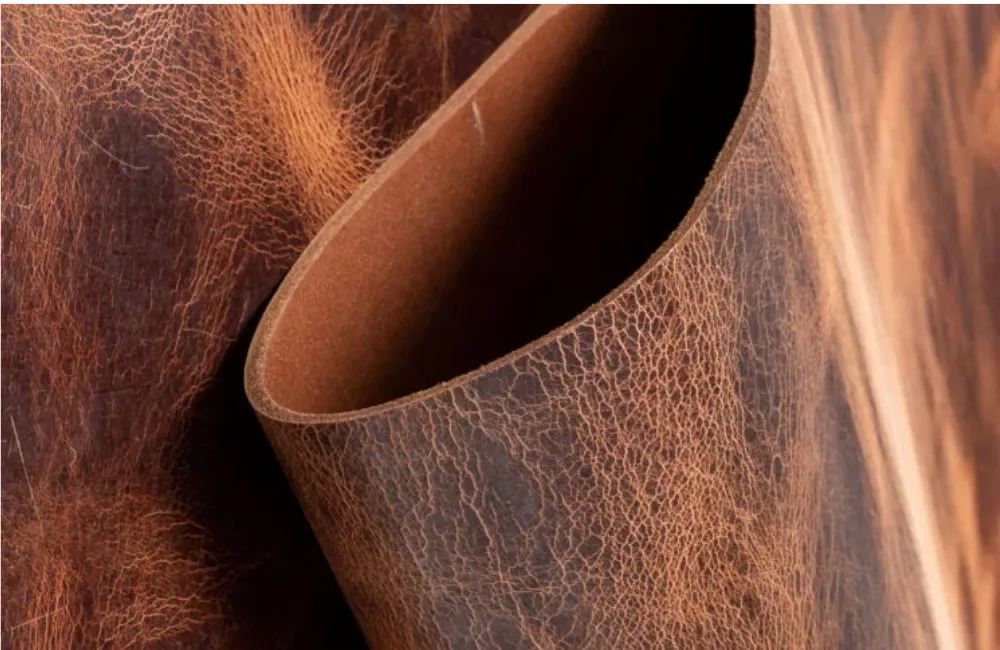
To truly appreciate buffalo leather’s unique place in the market, it’s helpful to compare it directly to other common types of leather. Each has its own strengths and weaknesses.
Buffalo Leather vs. Cow Leather
This is the most common comparison. While both are excellent, durable materials, they have key differences:
- Strength and Thickness: Buffalo leather is the clear winner here. Its hide is naturally thicker and has a less stretched fiber structure, making it more resistant to tearing.
- Texture: Buffalo has a much more pronounced, pebbled grain, giving it a rugged, earthy look. In contrast, cowhide has a smoother, finer grain.
- Cost: Cowhide is more widely available, which generally makes it more affordable than high-quality buffalo leather.
Buffalo Leather vs. Bison Leather
This is a point of frequent confusion. Although both are incredibly strong, they are distinct products.
Remember: “Buffalo” almost always refers to the Asian Water Buffalo, while “Bison” refers to the American Bison. Bison leather is much rarer and therefore significantly more expensive. It has a similar pebbled texture, but many aficionados claim bison has a subtler, more varied grain pattern.
Buffalo Leather vs. Sheep/Lambskin Leather
This is a comparison of opposites. Lambskin is known for its incredibly soft, supple, and lightweight feel, making it a favorite for luxury gloves and high-end jackets. However, it is very delicate and not very durable. In short, buffalo leather is the powerhouse, offering ruggedness and strength where lambskin offers delicate softness.
Buffalo Leather vs. Calf Leather
Calf leather, from young cattle, is prized for its smooth, fine grain and soft, luxurious feel. It’s a premium material used for high-end dress shoes and luxury handbags. Buffalo leather, in contrast, offers a much more rugged, textured, and masculine aesthetic. Ultimately, it’s a choice between polished refinement (calf) and earthy character (buffalo).
Comparison Table: Leather Characteristics
| Leather Type | Key Pro | Key Con | Best For |
|---|---|---|---|
| Buffalo Leather | Extreme durability, unique grain | Heavier, higher cost than cowhide | Rugged Bags, Jackets, Boots |
| Cowhide Leather | Versatile, affordable, widely available | Less durable than buffalo | Everyday Bags, Belts, Upholstery |
| Bison Leather | Very durable, unique American heritage | Rare and very expensive | Premium Heritage Goods |
| Lambskin Leather | Extremely soft and lightweight | Very delicate, not durable | Luxury Gloves, High-Fashion Jackets |
Pros and Cons of Buffalo Leather
Buffalo leather’s main advantages are its exceptional durability, unique rugged texture, and its ability to age beautifully by developing a rich patina. As a byproduct of agriculture, it also has strong eco-potential. However, its disadvantages include being heavier than cowhide, requiring regular maintenance to stay supple, and having a higher initial cost due to its premium nature.
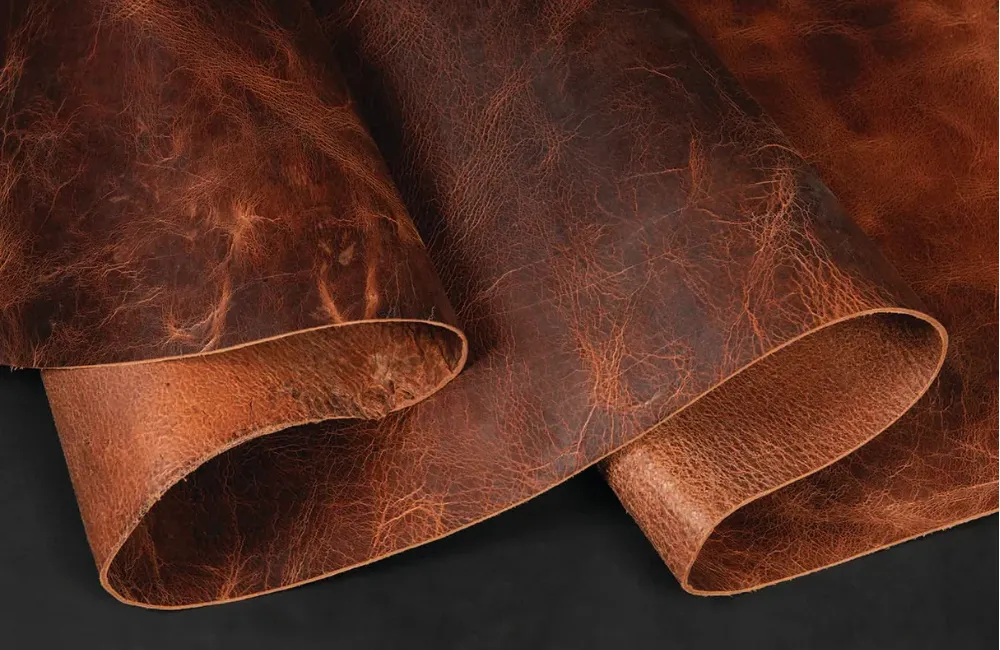
Advantages
Choosing buffalo leather comes with a host of benefits that make it a top-tier material for quality goods.
- Exceptional Durability: This is its number one selling point. It is thicker and stronger than cowhide, making it highly resistant to tearing and perfect for items that will see heavy use.
- Unique, Beautiful Aesthetic: The deep, pebbled grain gives it a distinct and rugged character that stands out from other leathers.
- Ages Beautifully: A full-grain buffalo leather product will develop a stunning patina over time, becoming more beautiful and unique with age.
- Eco-Potential: As a byproduct of the existing water buffalo farming industry in Asia, it is a sustainable choice that makes use of a material that would otherwise go to waste.
Disadvantages
Despite its strengths, there are a few trade-offs to consider.
- Heavier Weight: Its thickness and density mean that buffalo leather products are generally heavier than their cowhide counterparts.
- Higher Cost: Due to its premium qualities and sometimes more complex tanning processes, high-quality buffalo leather is typically more expensive than cowhide.
- Requires Maintenance: Like all high-quality natural leathers, it requires occasional conditioning to keep it from drying out and to maintain its suppleness.
Is Buffalo Leather Worth It?
Absolutely. For those who prioritize longevity and character, buffalo leather is one of the best investments you can make. A bag or jacket made from this material can last for decades, making its higher initial cost a great value in the long run.
Common Uses and Applications of Buffalo Leather
Buffalo leather’s rugged durability makes it ideal for high-wear items like bags, boots, and furniture. Its unique, deep grain is perfect for fashion accessories such as wallets and belts that require character. As a strong and weather-resistant material, it’s also a top choice for motorcycle gear. Its versatility extends from heritage-style goods to modern, sustainable fashion applications.
The unique combination of strength and beauty makes buffalo leather a highly versatile material, suitable for a wide range of products where durability is key.
Fashion and Accessories (Bags, Wallets, Belts)
This is where buffalo leather truly shines. Its rugged aesthetic is perfect for creating products that are both stylish and built to last. Common applications include:
- Messenger Bags and Backpacks: The material’s strength makes it ideal for bags that need to carry heavy loads like laptops and books.
- Duffel Bags: A full-grain buffalo leather duffel is a classic, durable choice for a weekend travel bag.
- Wallets and Belts: These high-contact items benefit from buffalo leather’s resistance to stretching and wear, ensuring they last for years.
Footwear and Apparel (Jackets, Boots)
The toughness and weather resistance of buffalo leather make it an excellent choice for protective outerwear. Manufacturers often use it for motorcycle jackets, as it provides superior abrasion resistance. It is also used for rugged, outdoor-oriented boots and work shoes that need to withstand harsh conditions.
Furniture and Upholstery
For furniture that will see a lot of use, like a family sofa or a club chair, buffalo leather is an outstanding choice. Its durability means it can stand up to the daily wear and tear of a busy household, including pets and children.
The rich texture also adds a warm, rustic, and inviting feel to any interior space, making it a favorite for high-end, comfortable upholstery.
Uses Table: At a Glance
| Product | Why Buffalo Leather is a Good Fit | Average Finished Product Cost |
|---|---|---|
| Duffel Bags | Extreme durability for travel, great patina development. | $200 – $600+ |
| Jackets | High abrasion resistance, good for protection. | $300 – $800+ |
| Wallets/Belts | Resists stretching and daily wear, unique grain. | $50 – $150+ |
| Furniture | Very durable for high-traffic use, comfortable. | $2000+ (for a sofa) |
How to Care for and Maintain Buffalo Leather
To maintain buffalo leather, gentle cleaning and regular conditioning are key. Wipe away dust with a dry cloth and use a slightly damp cloth for minor spills. Apply a quality leather conditioner every 3-6 months to keep it moisturized and prevent cracking. While naturally water-resistant, it is not waterproof; a protective spray can improve this. Proper care will ensure your buffalo leather lasts for decades.
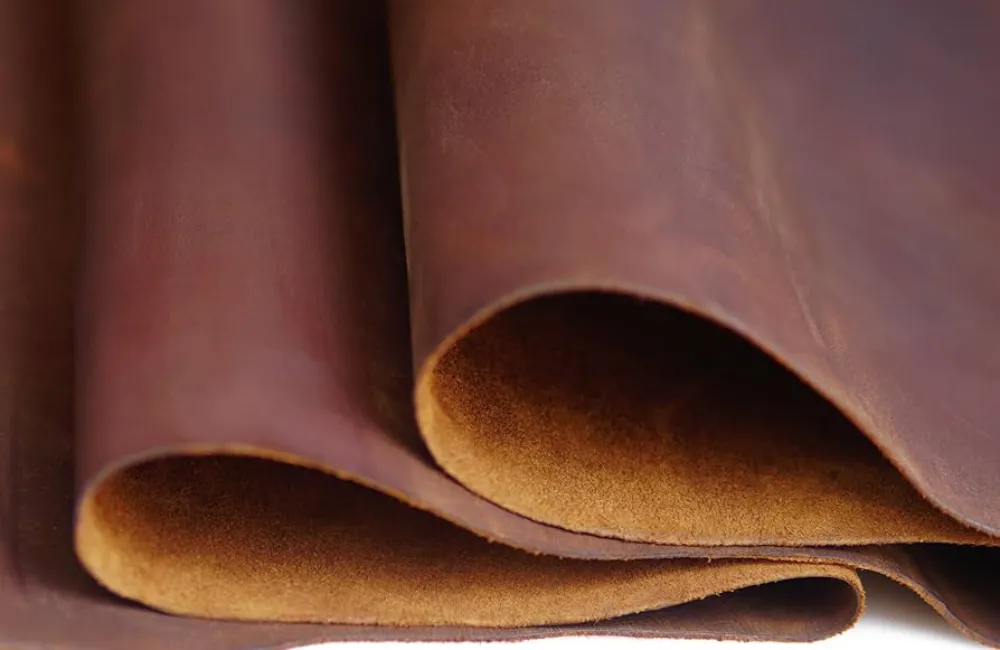
Buffalo leather is tough, but a little care will ensure it lasts a lifetime and develops a beautiful patina. Here are the essentials.
Cleaning Techniques
For general upkeep, simply wipe the surface with a soft, dry cloth to remove dust. For minor spills, use a cloth lightly dampened with water and wipe gently. Avoid using harsh soaps or chemical cleaners, as they can strip the leather of its natural oils.
Conditioning and Moisturizing
This is the most important step. Buffalo leather needs to be moisturized to stay supple and prevent cracks. Apply a high-quality leather conditioner or balm with a soft cloth every 3-6 months, or whenever the leather starts to feel dry. Use a small amount and work it in with a circular motion, then let it absorb before buffing off any excess.
Fixing Scratches and Wear
Minor scratches are a part of buffalo leather’s character and often blend into the patina. For a deeper scratch, you can often minimize its appearance by rubbing a small amount of leather conditioner or even your finger’s natural oils into the mark.
Waterproofing Buffalo Leather
Is buffalo leather waterproof? No, it is not inherently waterproof. Its natural oils provide a good degree of water resistance, meaning it can handle a light shower, but it should not be soaked.
For added protection, you can apply a waterproofing spray or wax specifically designed for leather. This will create a barrier against moisture without sealing the leather’s pores completely.
Care Table: Dos and Don’ts
| Action | Do 👍 | Don’t 👎 |
|---|---|---|
| Cleaning | Wipe with a soft, dry or slightly damp cloth. | Use harsh chemical cleaners or soak with water. |
| Conditioning | Apply a quality leather conditioner every 3-6 months. | Let the leather dry out and crack. |
| Storage | Store in a cool, dry place away from direct sun. | Store in a plastic bag or a humid environment. |
Sustainability, Ethics, and Pricing of Buffalo Leather
Buffalo leather is often considered a sustainable choice as it’s a byproduct of the existing meat and dairy industries, preventing waste. Ethically, traceability is key to ensuring animal welfare. While the tanning process has an environmental impact, choosing vegetable-tanned options can mitigate this. Its price ($4–$15/sq ft) reflects its premium quality, but its longevity offers excellent long-term value compared to less durable materials.
Environmental Impact
The primary sustainability advantage of buffalo leather is that it is a byproduct. Water buffalo are not raised for their hides; they are essential for agriculture and food in many parts of Asia. Using their hides to create durable goods is a form of recycling that prevents a valuable material from going to waste. However, like all leather, the tanning process has an environmental impact. Brands and consumers can make a more sustainable choice by opting for buffalo leather that has been vegetable-tanned, which avoids the harsh chemicals used in chrome tanning.
Ethical Considerations
The ethical standing of buffalo leather is tied to the welfare of the animals. Because they are typically raised on small, family-owned farms rather than in large industrial feedlots, they often live more natural lives. However, for brands, ensuring full traceability in the supply chain is crucial for verifying humane treatment. Compared to synthetic alternatives, which are petroleum-based plastics, many consider a natural, biodegradable byproduct like buffalo leather to be the more ethically sound long-term choice.
Buffalo Leather Prices
Is buffalo leather expensive? It is a premium material, and its price reflects that. It is generally more expensive than cowhide but less expensive than rare exotic leathers.
A high-quality, full-grain buffalo hide can cost between $4 to $15 per square foot, depending on the origin, finish, and tannage. While the upfront cost is higher than for many other materials, its incredible durability means it offers excellent long-term value, as products made from it will not need to be frequently replaced.
Frequently Asked Questions (Based on Google PAA)
Common questions about buffalo leather focus on its quality, durability, and key differences from other leathers. Buffalo leather is a high-quality, real leather known for being stronger and more rugged than cowhide. It is not waterproof but is naturally water-resistant. Its price reflects its premium nature, and with proper care, it can last for decades. It is distinct from American bison leather.
What is buffalo leather?
Buffalo leather is a strong, durable leather made from the hide of the water buffalo. It is known for its deep, pebbled grain and is a popular choice for rugged, long-lasting goods.
Is buffalo leather good?
Yes, buffalo leather is considered a very good, high-quality material. Its primary strengths are its exceptional durability, unique texture, and its ability to develop a beautiful patina over time, making it an excellent investment for heritage-quality products.
Buffalo leather vs cow leather?
Buffalo leather is generally thicker, stronger, and has a more pronounced grain than cowhide. Cowhide is typically softer, more flexible, and more affordable due to its wider availability.
How to care for buffalo leather?
Care for buffalo leather by wiping it regularly with a dry cloth, cleaning spills with a slightly damp cloth, and applying a quality leather conditioner every 3-6 months to keep it moisturized and prevent cracking.
Is buffalo leather waterproof?
No, buffalo leather is not waterproof, but it is naturally water-resistant due to its high oil content. It can withstand light rain, but should not be saturated with water. A waterproofing spray can be applied for extra protection.
What is the difference between bison and buffalo leather?
“Buffalo leather” typically comes from the Asian Water Buffalo, while “bison leather” comes from the American Bison. They are different species. Bison leather is rarer and more expensive.
Buffalo leather price?
High-quality, full-grain buffalo leather typically costs between $4 and $15 per square foot, making it a premium material that is more expensive than standard cowhide but less costly than exotic leathers.
Conclusion
Buffalo leather has rightfully earned its reputation as a powerhouse material. It offers a rare combination of rugged durability, unique character, and the potential for a rich, beautiful patina that tells a story over time. By understanding its origins, the different types available, and how to care for it, you can confidently invest in a product that is not just an accessory, but a lifelong companion. While it carries a premium price, its incredible longevity makes it a smart choice for anyone who values quality and is tired of the throwaway culture of fast fashion.
The key is to choose the right type of buffalo leather for your needs and to commit to its simple care routine. In return, you will be rewarded with a product of exceptional quality and timeless appeal. At Hoplok Leather, we have a deep appreciation for the unique qualities of this material. We specialize in sourcing the finest buffalo hides and crafting them into custom, high-quality goods that reflect our commitment to durability and style. Let us help you create a product that embodies the strength and character of this incredible leather.
Harness the Strength of Buffalo Leather for Your Brand
Ready to create a line of rugged, heirloom-quality products? At Hoplok Leather, we are experts in sourcing and manufacturing with premium buffalo leather. Partner with us to leverage our 22 years of experience and create custom bags, belts, and accessories that your customers will cherish for a lifetime. Let’s build something that lasts.



